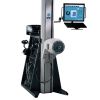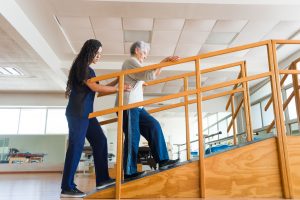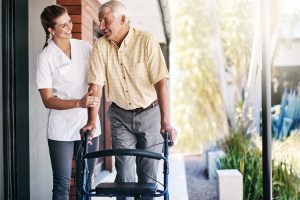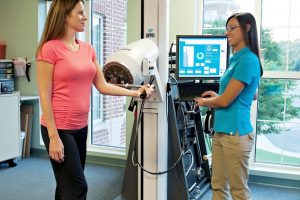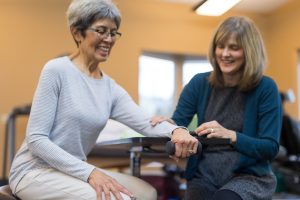
Grip Strength, Fall Risk, and the STEADI Initiative
Treatment GuidelinesThe CDC's STEADI initiative aims to reduce falls in the elderly population. Here we will explore each of these three parts of the STEADI initiative and how you can use it for fall prevention in your elderly clients.
Falls are the leading cause of injury among older adults in the United States. According to the CDC, each year in the United States, one out of four adults will fall1. The CDC encourages clinicians to use the Stopping Elderly Accidents, Deaths, & Injuries (STEADI) initiative in their practices. The three core elements of the STEADI initiative are:
- Screen all patients age 65+ for fall risk.
- Assess a patient’s modifiable risk factors and fall history.
- Intervene to reduce identified risk using effective strategies.
Here we will explore each of these three parts of the STEADI initiative and how you can use it for fall prevention in your elderly clients.
Screen All Patients Age 65+ for Fall Risk
The first part of the STEADI initiative is screening for fall risk. Identifying an older adult’s risk is important for fall prevention. One of the most important indicators of fall risk is grip strength. Measuring grip strength as part of a fall risk assessment is a well-supported evidence-based practice.
A 2013 study published in The American Journal of Medicine found that grip strength was directly related to other standard geriatric evaluation measures, such as Basic Activities of Daily Living (BADLs).2
Another study states, “…grip strength is largely consistent as an explanator of concurrent overall strength, …falls, ..and quality of life. Evidence is also provided for a predictive link between grip strength and…future function…”3
Data-driven Grip Strength Assessment
The best way to measure grip strength is to start with an objective baseline measurement. A baseline measurement allows the creation of an individualized treatment plan based on the collected data. Grip strength in adult populations can be objectively measured using a dynamometer.
Healthcare providers can evaluate a patient’s grip strength to determine how it compares to the data norms for that patient’s age group. Measuring again at regular intervals helps show how grip strength has changed over the course of treatment. This data is an important part of documentation, especially when communicating with other providers, referrers, patients, and insurance companies.
Assess Patient’s Modifiable Risk Factors and Fall History
The second part of STEADI is assessment of modifiable risk factors. Modifiable risk factors are things we can control. You can assess these by observing your patient as they perform a functional task or parts of a task, also known as a functional assessment. By observation or questioning, you’ll be able to determine which parts of the movement are contributing to your patient’s fall risk.
Functional assessments allow you to provide feedback to your patient about safety and body mechanics when engaged in a real task. This feedback will contribute to decreasing your patient’s fall risk. Functional Capacity Evaluations are a specific type of assessment – more on that here.
Like most evaluations, it’s best to collect objective data during a functional assessment. Tools like those found in BTE’s Evaluation and Testing family will enable you to track functional performance in realtime. If you use an advanced system like the EVJ, you can provide your patients (and referrers) with charts and graphs detailing their functional performance. This type of reporting helps your patients understand their progress and keeps them motivated to continue treatment.
Intervene To Reduce Identified Risk Using Effective Strategies
Last in the STEADI initiative is intervention. According to a grip strength study in American Journal of Medicine, “Purposeful activities build on a person’s ability and lead to achievement of personal and functional goals. Conversely, non-purposeful activities do not stimulate interest or motivation, resulting in reduced patient participation and suboptimal outcomes.”4 The use of function-based activities to decrease fall risk is effective and evidence-based. It is also a key component of the Choosing Wisely® initiative for the AOTA.
Using real-life tasks to improve strength has many benefits. Engaging clients in functional tasks increases patient engagement, thus improving their outcomes. Functional activity also recruits all the supporting muscles, which decreases the risk of injury. The following are functional treatment activities that can be implemented to increase grip strength and overall functional performance.
Self and home care activities such as:
- Ironing
- Pushing a vacuum
- Raking leaves
- Lifting groceries
- Opening a jar
Leisure activities such as:
- Swinging a golf club
- Gripping the handlebars of a bike
- Lifting grandchildren
- Controlling a dog’s leash
- Swinging a pickleball racket
Home and community mobility activities such as:
- Propelling a manual wheelchair
- Turning the steering wheel of a vehicle
- Turning a key to unlock a door
- Turning a doorknob
- Pushing a shopping cart
You can perform most of these functional activities (and the isolated movements leading up to them) in your clinic with the PrimusRS. You can also use the realtime data capture to improve neuromuscular control during functional activity.
Using Technology To Improve Functional Outcomes
Using technology for treatment is motivating and fun for many clients. According to peer-reviewed research published in JMIR Research Protocols, now is the time to integrate technology into patient care and hone those efforts for maximum success.5
The right technology will use goal-directed, client-centered, multi-plane movements with adjustable resistance that supports skill acquisition. It will also provide patient feedback in real-time about performance to maintain engagement and motivation in their individualized treatment plans.
Conclusion
The CDC’s STEADI initiative can be implemented by using objective, quantitative measures as well as function-based assessments and tasks. Successful execution of this program will promote patient success in activities of daily living with a decreased fall risk.
Tasha Perkins Holmes, MOT, OTR/L, BCP
Tasha Perkins Holmes, MOT, OTR/L, BCP is an Occupational Therapist, telehealth expert, and freelance healthcare writer. She has created continuing education courses for allied health professionals as well as instructed future healthcare professionals. Writing is a means for her to share her knowledge about healthcare topics that are important to healthcare providers and consumers. Writing also provides a way for her to advocate for equitable access to healthcare and to increase the healthcare literacy of the public. Feel free to reach out on LinkedIn or Upwork.
References
- Centers for Disease Control and Prevention. (2020, December 16). Keep on your feet-preventing older Adult Falls. Centers for Disease Control and Prevention. Retrieved September 3, 2022, from https://www.cdc.gov/injury/features/older-adult-falls/index.html
- RW;, B. (n.d.). Grip strength: An indispensable biomarker for older adults. Clinical interventions in aging. Retrieved September 3, 2022, from https://pubmed.ncbi.nlm.nih.gov/31631989/
- Savino, E., Martini, E., Lauretani, F., Pioli, G., Zagatti, A. M., Frondini, C., Pellicciotti, F., Giordano, A., Ferrari, A., Nardelli, A., Davoli, M. L., Zurlo, A., Lunardelli, M. L., & Volpato, S. (2013, September 19). Handgrip strength predicts persistent walking recovery after hip fracture surgery. The American Journal of Medicine. Retrieved September 5, 2022, from https://www.amjmed.com/article/S0002-9343(13)00482-8/fulltext#articleInformation
- Foundation, A. B. I. M. (2018, July 17). Non-purposeful intervention activities: Choosing wisely. Choosing Wisely | Promoting conversations between providers and patients. Retrieved September 4, 2022, from https://www.choosingwisely.org/clinician-lists/aota-non-purposeful-intervention-activities/
- McAlearney AS, Sieck CJ, Hefner JL, Aldrich AM, Walker DM, Rizer MK, Moffatt-Bruce SD, Huerta TR. High Touch and High Tech (HT2) Proposal: Transforming Patient Engagement Throughout the Continuum of Care by Engaging Patients with Portal Technology at the Bedside. JMIR Res Protoc. 2016 Nov 29;5(4):e221. Retrieved September 3, 2022 from https://pubmed.ncbi.nlm.nih.gov/27899338/

